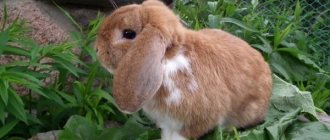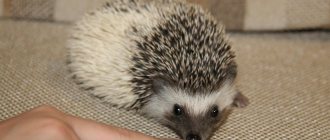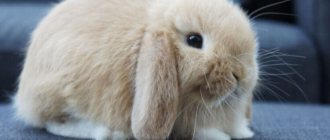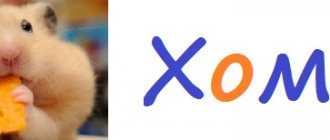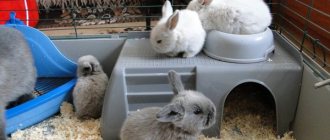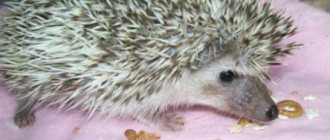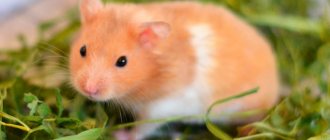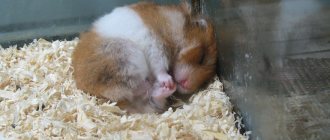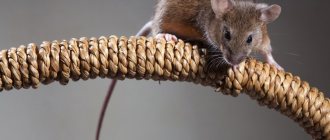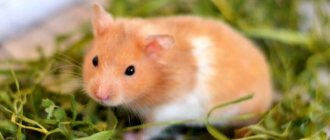The list of pets is not limited to cats, dogs and hamsters. No one is surprised by people with mini pigs on a leash, and many people have dwarf rabbits in their homes - cute animals that evoke universal affection with their appearance. The peculiarity of mini breeds is that they remain miniature even in adulthood, in contrast to decorative rabbits, which are no less attractive in appearance, but grow to industrial sizes.
What is the difference between a dwarf rabbit and a decorative one?
So that, as an adult, the rabbit does not surprise you with its size, you should ask the seller for a certificate
People often wonder: what is the difference between dwarf rabbits and decorative ones. First of all, these are the sizes. When ornamental animals grow up, they can become very large.
But in childhood, all rabbits are small, and it is difficult to independently distinguish a dwarf individual. To avoid mistakes, you need to ask the seller or breeder to present a certificate or show the parents of the future pet.
Choosing a cell
When choosing a cage for your pet, pay attention to the absence of sharp corners that could injure your pet.
Even the drinking bowl and feeder should have rounded shapes. Choose a cage with a coating that will prevent your rabbit's feet from slipping on the floor.
The cage must have ventilation. As a shelter for the rabbits, you can choose a cardboard box or a small wooden box.
Breeds and general description
You will be surprised, but this is exactly what a dwarf ram looks like
When the decision to have a dwarf rabbit has been made, you need to decide on the choice of breed. Such animals are colored and white, and their weight ranges from 700 g to 3 kg.
The following breeds can be found in nurseries and pet stores:
- Dwarf ram;
- Dwarf rex;
- Foxy dwarf rabbit;
- Angora dwarf rabbit;
- Japanese dwarf rabbit;
- Dwarf hare;
- Dwarf rabbit Hermelin;
- Dutch dwarf rabbit.
Angora rabbits are particularly fluffy
Both the appearance and character of the animals depend on the purity of the breed. Some long-eared ones resemble a ball and are very peaceful, while others have rather short fur and a more aggressive character. So, first of all, the animal must evoke sympathy.
Features of dwarf breeds
Dwarf breeds were developed through domestication and selection of wild representatives. The purpose of keeping them is not a beautiful skin or meat, but only aesthetic beauty. You can read how to keep a decorative rabbit in an apartment at this link.
When purchasing, it is clearly necessary to understand the difference between simply decorative rabbits and dwarf breeds. Dwarf breeds are miniature and sometimes do not reach 1.5 kg (loop-eared ones weigh up to 2.5 kg; and decorative ones, on the contrary, can be quite large representatives. Examples of such breeds are the Burgundy rabbit and the Chinchilla.
Under good, non-stressful living conditions (timely and varied food, drink, regular cleaning and absence of loud sounds), rabbits live with their owners for up to 12-13 years. Experts advise immediately neutering pets so that they do not cause discomfort with further restless behavior. Read more about how to care for decorative rabbits.
The dwarf breed is distinguished immediately by its ears. They are not long, up to 6 cm; although there are separate subspecies whose ears can be up to 20 cm. But this is an exception to the general rule.
The rarest color or variety will cost much more than the more common breed.
Dwarf rabbit breeds are distinguished by their ears
Pros and cons of content
Dwarf rabbits are affectionate and clean, but very susceptible to disease
There are advantages and disadvantages to owning these small, cute animals. Let's start with the pros:
- Cleanliness. Dwarf long-eared cats quickly become accustomed to the litter box, and there is very little litter from them in the apartment.
- These are affectionate, kind pets that immediately become attached to their owners. When they are happy, they click their teeth funny and make pleasant sounds.
- Rabbits are unpretentious in care and nutrition, and their maintenance is quite inexpensive.
The main disadvantage of animals is their pain. They can fall ill not only from infection, but also from sadness. Frequent visits to the veterinarian can take a lot of effort and time. Another disadvantage is the problem of constantly gnawing on something. Buying toys will help solve the problem: the rest of the things in the house will remain intact.
It is also worth considering that each rabbit, despite its small stature, is a personality. They are very touchy and remember bad treatment for a long time.
Hotot
A small white rabbit with a black border around the eyes. The weight of this baby is a little more than 1 kg. The ears are small, up to 7 cm long. The fur is soft and pleasant to the touch.
These pets are very cheerful, they need to exercise a lot, and they are always happy to play with their owner. Hotots are smart animals and, with proper training, are capable of following simple commands.
Care and maintenance at home
Keeping long-eared pets is not particularly difficult. It is important to choose a healthy animal and prepare a suitable room for it. It should be well ventilated, but without drafts. Heat is also contraindicated for rabbits; they cannot be placed near a radiator.
It is better to buy a cage with galvanized metal rods. Two males will not get along in it, but females or rabbits of different sexes can be placed together. Of course, the size of such a house should be larger.
Many breeders are afraid of unpleasant odors. If you properly care for animals, they will not exist. At the bottom of the cage, it is necessary to pour bedding from pieces of newspapers, sawdust or straw in time. These materials absorb odors well and can be quickly removed.
Long-eared dogs with thick hair need to be brushed regularly. In addition, approximately once every 3 weeks your pet needs to have its claws trimmed.
What to feed a dwarf rabbit
Dwarf rabbits can eat up to 30 times a day
Dwarf rabbits are big eaters: they eat up to 30 times per day. The owners must provide them with adequate nutrition and not restrict food, otherwise they can harm the digestive system. The food that the animal eats is quickly digested and reaches the intestines only after the next meal.
A pet's diet should be varied. It is better if it is based on ready-made balanced food from pet stores. You can also give hay. If the eared dog refuses to eat it, the hay is slightly moistened with water and salt.
The menu must be supplemented with grass, including meadow grass, as well as bone meal and chalk - a long-eared animal cannot do without minerals. It is useful to give oats or wheat soaked in water, fresh fruits and vegetables.
Important: You can give cabbage, which rabbits love, but red cabbage is contraindicated for them.
Sometimes rabbits eat the waste left in the cage. There is no need to be afraid of this: they are harmless to long-eared animals.
Hygiene and bathing
You should only bathe babies if they are very dirty.
Since dwarf rabbits are very clean, there is no need for regular bathing. But if the baby gets very dirty at home or on a walk, it is better not to let him clean himself, but still give him a bath. The rest of the time, you should not expose your baby to stress. He will take care of his own skin, which is also replaced with a new one every six months.
Diseases and treatment
Vaccines and vaccinations are necessary for dwarf rabbits. These gentle creatures, even in comfortable room conditions, can catch a disease such as a cold or conjunctivitis. Both hypothermia and heat stroke are equally dangerous for them. Timely vaccinations will protect rabbits from infections and dangerous diseases such as rabies.
Therefore, the condition of pets must be constantly monitored. The following symptoms may indicate the disease:
- Vomiting, nausea, bloating.
- Loose stools or constipation.
- Belching, rumbling in the stomach, bad breath.
- Fatigue, lethargy, drowsiness.
Even if there are one or two symptoms, the baby should be shown to the veterinarian: delay can be disastrous for him.
Vaccination
The smallest rabbits are protected from diseases by maternal immunity. When they switch to adult food, the body weakens. Vaccinations can begin as early as the sixth week. Animals are vaccinated against rabies, salmonellosis, listeriosis and some other diseases.
Before vaccination, you need to prepare: take care of the prevention of helminthic infestation, monitor the pet’s health, and stop bathing it a week before.
Selecting a cage and accessories
Take care in advance of entertainment for the rabbit in the cage
The dwarf rabbit is a delicate and fragile breed, which must be taken into account when choosing a cage. It is desirable that each individual has its own house. Its size must be 4–5 times the size of an adult rabbit so that the animal can move. It is advisable that its rods be made of unpainted iron: when the baby gnaws on them, his health will not suffer . It is better to choose a plastic pallet.
It is worth taking care in advance about purchasing accessories: tray, feeder, drinking bowl, toys. You also need to buy a manger into which hay will be poured. This is necessary because it quickly deteriorates on the floor.
Characteristics of rabbit fluff
The fur of a downy rabbit consists of 2-8% awn and 92-98% fine downy hair, the length of which can reach 20 cm. It is particularly soft, hypoallergenic, uniform and does not require additional combing, degreasing, washing and drying.
Rabbit down is widely used to make warm clothes. And although it is inferior in strength to the fur of other animals and wears out faster, its thermal insulation characteristics are much higher than those of sheep's wool. Therefore, it is often used for the production of children's clothing.
Interesting! The most valuable is the fluff that is cut from the rump, thighs and back of the rabbit. And the fur from the animal’s abdomen, shoulder blades and chest is of lower quality.
Breeding dwarf rabbits
When breeding rabbits, the key is moderation.
A feature of decorative rabbits is the possibility of early mating. They reach sexual maturity in 6–9 months. At this time, the animals are ready to reproduce. At one time, a female rabbit brings on average 5–7 babies. Breeding rabbits too often is not recommended, as this may affect the quality of the offspring.
How to determine the sex of an animal
Rabbits aged one to two months are practically indistinguishable from each other. The sex of animals can only be determined from documents. The genitals will help determine it externally. The animal must be placed with its belly up on its hind legs. After this, the tail is raised and the genital organ is gently squeezed. The male will have a penis, while the female will have a pink triangle.
Mating and pregnancy
Be prepared that a female rabbit ready for mating will dramatically change her behavior
It is best to breed a dwarf rabbit under the age of one year . When she is ready to breed, her character changes dramatically. The female becomes restless and irritable. At this time, it’s time to place her in the male’s cage, where she will become more docile. Mating occurs almost immediately. Then the animals need to be left alone for a while, and then seated. A day after this, control mating occurs.
Pregnancy in females lasts on average 31 days. If the litter is small and the offspring are large, it may last longer. When there are many rabbits, their mother will give birth faster.
During the first two weeks, the female's diet does not need to be changed. Starting from the third week, the dose should be increased slightly. The menu of the expectant mother should include fruits and vegetables, especially cucumbers: they are believed to enhance lactation. But you still shouldn’t overfeed your rabbit.
How to care for newborn dwarf rabbits
Rabbits are born deaf, blind and require special care. Their mother will look after them, and the owners must provide her with conditions and additional food. It is necessary to prepare a warm place for the offspring in advance: if the rabbits are placed on the floor, they will die.
There is no point in disturbing the rabbit again: she may get scared and harm the newborns. But you will have to make sure that she is always full and does not eat the babies. There is no need to worry that the female spends little time with the children. Unlike dogs and cats, rabbits do not sit with their offspring all the time, but only come to feed them.
Classification of breeds of decorative rabbits with photographs
There are about 200 species of decorative rabbits. In order not to get confused in the diversity, there is a strict classification system:
- by size (large, medium, dwarf);
- by coat length (long-haired, with normal length hair, short-haired);
- by color.
Let's take a closer look at the most popular of them.
Dutch dwarf rabbit
The ancestors of these short-haired babies come from Holland. It was there, in the 15th century, that the first drawings of similar animals were made, and in the 19th century the breed standard was officially formalized. Nowadays Dutch rabbits are distributed all over the world.
But their domestication was quite difficult. Only after several generations did the animals acquire the character traits for which they are now so valued.
At the moment, this is one of the most nimble, energetic, unpretentious breeds. Therefore, even an inexperienced owner can handle such a baby perfectly.
The Dutch rabbit is easily recognized by its contrasting colors. He has a white chest, front paws and a stripe on his face. Dark head, ears and back of the body. Outwardly, it seems that the baby is wearing a tuxedo. Although there are also monochromatic animals. Interestingly, the color of the rabbit's eyes completely matches its color.
Adults weigh 1.7 kg. And with proper care they can live up to 10 years.
The cost of Dutch dwarf rabbits is 4500 - 5000 rubles.
Dutch Fold
Fold rabbits, including Dutch ones, are very popular among breeders. This is a young breed that appeared in the middle of the 20th century.
The animals have a neat round head with charming drooping ears, 22-27 cm in length. It is noteworthy that babies are born with protruding ears; they begin to droop at the age of two months. The coloring of this breed is varied, from red to chinchilla.
Babies weigh up to 1.5 kg. They live for about 7 years.
Dutch Folds have a friendly character and are easy to handle. With proper upbringing, they begin to respond to their nickname quite quickly.
Such rabbits cost about 2,000 rubles. But for a baby with a good pedigree you will pay much more.
Dwarf ram
The pygmy ram is the smallest lop-eared rabbit. This baby is 28 cm tall and weighs about a kilogram.
The breed received a strange name for its large muzzle, which looks like the head of a ram. The animals have a dense build, a large head, a short neck, and muscular legs.
The main decoration of the dwarf ram is its long (up to 28 cm), fleshy ears, pressed tightly to the head and forming a kind of crown. Like all lop ears, they stick up at birth and fall off by three months. Their fur is soft and delicate. About 22 colors were developed.
The kids are gentle, energetic, quickly get used to the place, and make contact well.
With proper care, the life expectancy of a dwarf ram is 6-7 years.
But their bones are quite fragile, so it is better to get a rabbit of this breed when children are already grown up and cannot unknowingly harm it.
Lambs starting at 4 months of age are sold and cost from 1,500 to 3,000 rubles. But the price of an animal of rare color can reach up to 10,000.
Pygmy
These cute babies, about 20 cm long and weighing only half a kilogram, are found in the wild. Pygmy minks can be found in the deserts of Utah, Nevada, California, and Idaho. However, animals feel great at home.
Pygmies differ from other decorative breeds in their more natural coloring. Their back, head and small erect ears are gray with brown spots, their abdomen and paws are light. Interestingly, due to their short legs, these rabbits hardly jump.
As a desert dweller, the pygmy does not like the cold. Therefore, the baby rabbit must be provided with suitable conditions.
In nature, the lifespan of these rabbits is about 3 years, but at home, pygmies live more than 5 years.
Buying a pygmy baby is not easy, but there are nurseries that specialize in breeding this particular breed. The price for a baby rabbit there starts from 2,500 rubles.
Dwarf butterfly
You can easily recognize these rabbits by a clear spot on their face, which in its outline resembles a butterfly. Thanks to him, the breed got its name.
The first miniature rabbits with unusual patterns appeared in England. Now they have a large circle of admirers all over the world.
Dwarf butterflies weigh about 1.5 kg, have an oblong body, a large head, and neat, close-set dark ears.
Most animals are white with a black spot. But you can find individuals with brown or blue “butterflies”.
Rabbits have a calm, friendly character. They live for about 7 years. But caring for dwarf butterflies is difficult. They are very susceptible to living conditions, so they often get sick.
For an eared pet of this breed you will have to pay 1,200 to 6,000 rubles, it all depends on the pedigree of the animal.
Pygmy hare
The dwarf hare is distinguished by a neat white coat with small spots scattered throughout it, which are almost invisible in a newborn baby. Its dark ears, paws and tail stand out effectively against the background of the overall light coloring.
The rabbit has a proportional build, a slightly elongated body, ears pointed at the edges and red eyes.
Weighs up to 2 kg. Lives at home for about 7 years.
The dwarf hare is a sweet, kind-hearted animal whose communication brings a lot of pleasure.
Its cost starts from 1,500 rubles. The most expensive are the silver fox hares; their prices start at $100.
Dwarf rex
Translated, the name of this breed means “king of beavers.” The fact is that bred at the beginning of the 20th century. The small rabbits had unusual fur, the color of which resembled beaver fur.
The dwarf rex is truly unique. They have the shortest hair (1.5 cm) and the smallest whiskers among all decorative rabbits. They have a dense body, short legs, a narrow head, and medium-length ears (up to 7 cm).
The colors of Rex can be varied. The rarest animals are white.
Rabbits of this breed are calm, good-natured, but are afraid of drafts and are sensitive to sharp sounds.
Adults weigh 1.8 kg. In good conditions they live up to 6 years.
Rex females are not fertile, so the price for a baby that meets the standard starts at 3,500 rubles.
Squirrel
Rabbits of this breed are both decorative and meat-skinned.
The animals have very unusual colors. It is to her that squirrel rabbits owe their name. Their abdomen is a lighter shade compared to the rest of the body.
Squirrels have an elongated body, a wide back and chest, neat small ears, and strong muscular limbs.
Females are distinguished by good fertility. There are 5-6 rabbits in one litter.
An adult weighs up to 4 kg.
Unfortunately, this breed is not common in Russia. Therefore, if you decide to get a squirrel rabbit, you will have to buy it in Europe. The cost of one animal there starts from 100 euros.
Hermelin
Hermelin is a small rabbit, pure white with gray or red eyes. The second name of the breed is “Polish ermine”. They appeared in the middle of the last century in Western Europe, where they are now in great demand.
These rabbits have a round head, short legs, small erect ears, a wide muzzle with a button-like nose.
Hermelin is a long-lived rabbit; with proper care, its life expectancy ranges from 8 to 12 years.
The animal is affectionate and playful, but only when it is given daily attention. Otherwise, Hermelin becomes withdrawn, aggressive, and shows character.
For a white fluffy you will pay about 3,000 rubles.
We bring to your attention a video “top 6 reasons” why you should get a rabbit.
Fox dwarf
These miniature rabbits, dressed in a bright red robe, were bred in the 80s of the twentieth century in Austria. There are several varieties of the breed: “Swiss fox”, “Belgian fox”. Their main difference is the color of their long (up to 7 cm) fur. There are foxes of red, chinchilla, white and various shades.
Fox rabbits weigh up to 1.5 kg. They are distinguished by a shortened body, a large head, and protruding, closely spaced, hair-covered ears of a small length (5 cm).
Kids are active, affectionate, playful. They live up to 8 years.
You can buy a dwarf fox rabbit with a veterinary certificate for 2,500 rubles.
Angora dwarf
If you imagine a fluffy ball with protruding ears and a small nose, then this is a dwarf angora rabbit. The breed appeared more than 300 years ago in Turkey. However, until now, breeders have not abandoned the idea of bringing fluffies with the longest fur possible. Therefore, new species appear regularly. Thus, in 2014, the “Russian dwarf angora” was registered.
The Angora dwarf has an oblong body, a round head, and straight erect ears (up to 7 cm). But due to the long hair, it is almost impossible to discern the animal’s physique.
The color of fluffies is predominantly one-color (white, red, blue), although there are also two-color ones (gray and white, red and white).
Angoras are a little clumsy, but gentle and funny. Having such a pet, you need to devote considerable time to caring for its fur.
An adult weighs up to 1.7 kg. They live for about 5 - 6 years.
Breeders sell long-haired rabbits for 4,500 - 6,000 rubles.
Angora lion
This relatively young breed of rabbits received its name due to the color and arrangement of its fur.
Long, up to 6 cm, fur of a brownish-red hue grows in babies all over the body, including short erect ears and a small head. A feature of the breed is also a small tuft on the top of the head.
Angora lions are small, sociable, good-natured lions (up to 1.6 kg). With a caring owner, such a rabbit can live up to 7 years.
However, you should remember about the rules of hair care and a balanced diet for the animal.
You can buy an Angora lion at a pet store for 1,500 rubles.
Lion head
More recently, these long-haired rabbits with a funny crest and beard were bred - the second variety of the lion breed.
Their body is round, their chest is wide, and their limbs are muscular. The head is decorated with short, erect ears. On the neck you can distinguish a mane, single or double.
The colors are mostly monochromatic. The most popular are: white, chinchilla, opal, blue, sable.
An adult weighs up to 1.75 kg. Lives for about 7 years.
These dwarf lions have a friendly disposition. However, the breed is still in the breeding stage, so the animals may show aggression that is unusual for them.
The cost of a lion's head rabbit starts from 1,500 rubles.
Colored dwarf
These funny short-haired babies were bred in Holland. Initially, representatives of the breed were only ash-gray in color, but the palette of colors began to grow. To date, more than 20 different shades have been released. Thanks to this, the colored dwarf got its name.
The animal is distinguished by its light weight - 1.2 kg, strong build, small ears up to 6 cm, on a shortened head.
The colored dwarf quickly gets used to the owner and greets his appearance every time, rising on his hind legs.
With proper care, their life expectancy is 8 years.
Colored dwarf rabbits cost 2,000 rubles. However, for completely snow-white babies or white ones with black circles around the eyes (Oto color) you will have to pay up to 10,000.
Ognevka
One of the unusual breeds. The moth got its name because of its red fur, which seems to scorch fragments of the rabbit’s dark body. Thus, these animals have distinguished eyes and nostrils. On the contrary, the paws, tummy and hanging ears remain dark.
Adults grow up to 3 kg, their body length reaches 70 cm.
Ognevki are kind and open. Although due to their size they are not very popular among breeders.
The cost of an animal with all necessary vaccinations is 3,000 rubles.
Hotot
A charming little white rabbit with a black rim around its eyes will not leave anyone indifferent. The ideal weight of a laughter is 1.1 kg. The baby has a compact build, resembling a regular semicircle in profile.
Purebred hotota is only white in color with a small, up to 3 mm, black outline around the eyes. Although babies have been bred with chocolate and blue eyeliner.
Rabbits are active and cheerful. In good conditions they live for about 8 years.
You can buy a Hotot baby from a breeder for 2,000 rubles.
Japanese dwarf
This breed of lop-eared rabbits is valued by breeders because of its unusual color. One side of them is an opal-light color, the other is dark, the colors seem to meet on the spine. The coloring on the animal's face is combined in the same way. Moreover, on the light side of the head there will definitely be a dark ear.
The weight of an adult animal is from 800 to 1500 grams. Life expectancy is 6 years.
The Japanese rabbit is not picky about its living conditions. Therefore, it is suitable as a first pet.
However, due to the unusual color, fluffies cost from 3,500 rubles.
Minilop
Little lop-eared Minilop rabbits make you fall in love at first sight. These animals have a compact, stocky body, a neat head with deep-set eyes and long ears. The color is varied, there are both single-color and two-color individuals.
These babies weigh on average 1.2 kg. They live 5 years.
However, breeders do not like the breed due to the difficulties in breeding them. The genotype of the animal is not yet fully formed.
But as a pet, minilops are simply ideal. They are friendly, sociable, and get along well with other animals.
You can buy a baby rabbit for 2,500 rubles.
Rabbit minor
This is one of the smallest breeds of decorative rabbits.
It weighs an average of 1 kg and can easily fit in a man’s palm.
Therefore, even an adult individual looks like a small rabbit.
The animals have a neat body, a round head, short ears, and large expressive eyes. Minors are most often monophonic. There are several basic colors. But breeders are working to obtain new combinations.
Rabbits do not require special care, they are obedient and kind.
The price for these babies starts from 4,500 rubles.
English fold breed
Here is a decorative giant rabbit.
Representatives of the English Fold breed weigh 5.5 and reach a fairly large size.
But their main advantage is their ears. These beauties have simply magnificent ones, long, wide, from 53 cm.
An English lop-eared rabbit with ears 79 cm long is listed in the Guinness Book of Records.
There are two types of color of such rabbits: spotted and solid.
English Folds are calm, friendly animals. But when buying such a pet, keep in mind that long ears require special care.
Such an eared one costs from 4,000 rubles.
Satin
This giant is quite in demand among breeders, thanks to its bright satin coat. The satin rabbit weighs 5 kg. They are distinguished by their proportional build, strong paws and small, even ears.
In terms of variety of colors, satins are not inferior to colored rabbits. There are individuals of blue, lilac, copper, chocolate, and Siamese shades. The most popular among breeders are striped and curly-haired giants.
The satin rabbit is kind, flexible, and sometimes too lazy. Under good conditions, its life expectancy is 6-8 years.
For lovers of dwarf species, breeders developed the Mini Satin breed. They weigh up to 2 kg, but have the same luxurious fur.
For a satin rabbit you will have to pay 3,500 rubles. Dwarf satin babies cost from 2,500.
Florida white
The breed will appeal to those looking for a medium-sized rabbit, not a dwarf or a giant.
Adult animals weigh on average 2.2 kg, have a dense build, and small pointed ears.
Florida rabbits have soft, fluffy fur. Color only white. The eyes are red.
This is an excellent show animal, with good genetics and an easy-going character.
You can buy a rabbit for 3,000 rubles.
Havanese
Havanese and Florida rabbits are very similar in appearance. Only, unlike their snow-white counterparts, these eared animals are completely black.
Rabbits reach medium size, weigh up to 3 kg, and have red eyes.
The first representatives of the breed were chocolate-colored. Now two more colors have been developed: black and blue.
Havanese rabbits are considered one of the calmest decorative breeds.
Despite the fact that these rabbits are so popular in Europe, they are not widespread among Russian breeders. Therefore, such a rabbit is difficult to find on sale.
Training and playing with your pet
Decorative rabbits just love to play
Dwarf rabbit breeds love to play and can learn some interesting tricks. They perceive training not as coercion, but as an opportunity to have fun. To achieve success, you need to eliminate negativity and aggression from the educational process. The best assistants in training will be praise and treating your pet with treats.
You should not start training your baby immediately after purchase. We need to give him a couple of months to adapt, after which he can begin training.
The smallest rabbit in the world
Molossians (dogs): breed varieties and overview
According to the Guinness Book of Records, the smallest rabbit in the world is a pygmy. The weight of the animal is 400 g, and the body length barely reaches 27 cm.
Pygmy
Thus, it was explained what the smallest breeds of rabbits look like. The choice among them is quite large. But before buying, you need to read about the temperament of pets, so that the eared baby does not end up growing into an aggressive pet, surprising the breeder.
How to toilet train an animal
Accustoming a baby rabbit to a litter tray requires a lot of patience from the owner.
The little rabbit is gradually getting used to the toilet, but you will have to be a little patient. It is advisable to remember in which corner the breeder had the tray and place it there at home. It is worth asking the breeder for some used litter and mixing it with the old one. The pet will quickly find its native smell.
If the baby doesn't get into the tray, there's no need to swear. As soon as it becomes noticeable that your pet wants to go to the toilet, you must immediately put him in the litter tray. After a job done successfully, the animal should be praised. If you patiently train your pet to use the toilet day after day, the result will be achieved.
Lion head
The lion-headed rabbit has small pointed ears, a cute crest above a cute face and, of course, a mane. The breed has about 60 different coat colors. Pets weigh up to 2 kg.
These rabbits are friendly and peaceful, they love to play and often come to their owner for affection. Training “lion cubs” is not very easy, but with due diligence, the pet can learn a few simple commands.
What to name a dwarf rabbit
Choosing a name for these affectionate creatures is not an easy task, because you want your pet to have the most beautiful one. At home, rabbits are called completely differently than on farms.
The name has a certain influence on the character of the pet. A rabbit whose nickname sounds soft has a more docile character than an animal with a harsh name. When choosing, you can take into account body type, color, and other appearance features.
For boys, the names Coal, Ryzhik, and Donut may be suitable. Popular rabbit names are Yasha, Fomka, Stepan. Female rabbits readily respond to the nicknames Bunny, Smokey, Pushinka. Girls with a proud, unapproachable character are given names such as Eva, Gerda, Magnolia.
To quickly accustom your baby to his name, you need to call him as often as possible . If the name is sonorous and short, there will be no problems.
Minilop
Minilop is a lop-eared rabbit. However, this breed's ears do not droop as much as those of Lambs. Babies are very reminiscent of a plush toy. The breed is quite difficult to breed. It is lightweight - up to 1.3 kilograms. The body of rabbits is quite massive, the head from the side looks like a ball. The color can be varied, the wool is thick and thick. Minilops are very playful and friendly animals, so they are quite popular among lovers of such animals.
Lion-headed individuals got their name for the specific growth of their fur.
Colored dwarf
This breed is also known to many as the short-haired dwarf rabbit. Typically, the body weight of an adult colored dwarf can range from 800 grams and barely reach one and a half kilograms . The animal's ears are always positioned upright, their length can vary from 5 to 5.5 cm. Despite their miniature size, practically absent neck and small body, the paws of rabbits of this breed are very strong. At the moment, more than 60 colors of the colored dwarf have been recorded. The fur coat of these pets has a very neat appearance and does not require special care.
It should be noted that during puberty, rabbits of these breeds can show aggression towards the owner, even sometimes biting or hitting with their paws. Typically, maturation occurs at one and a half years. Many sellers recommend spaying or neutering these animals to reduce aggression.
To summarize, we can conclude that the colored dwarf is quite funny and perfectly plays the role of a charming, active and funny pet.
